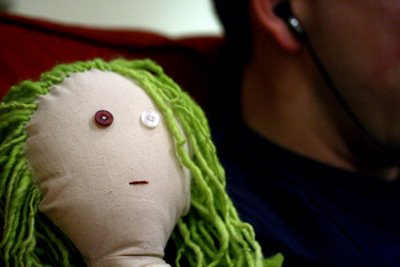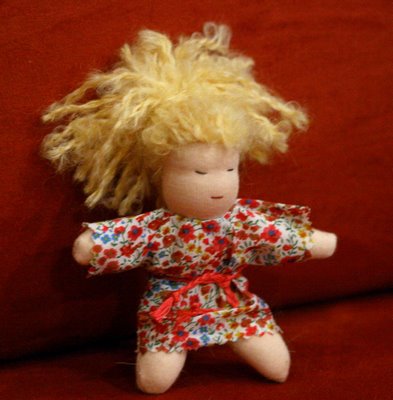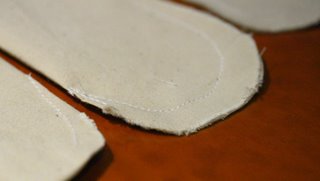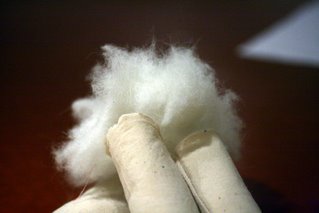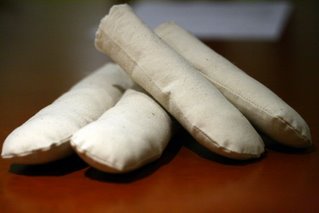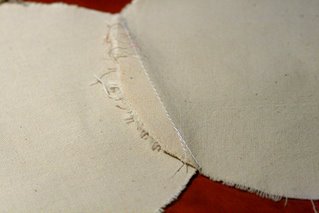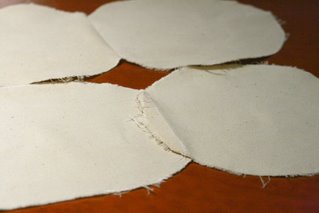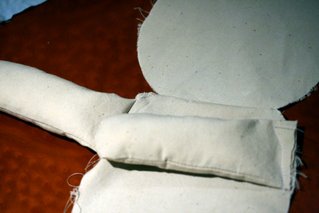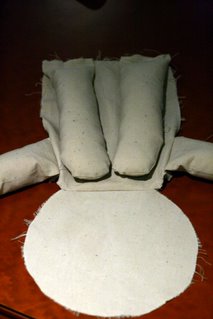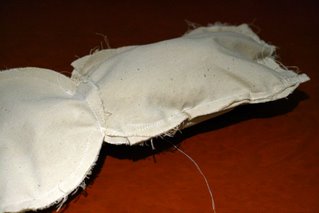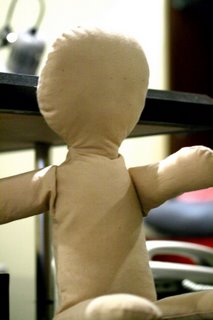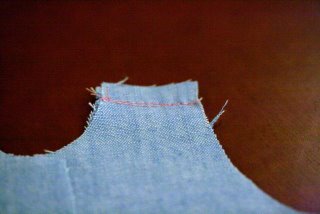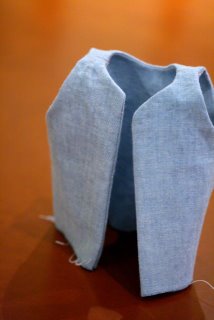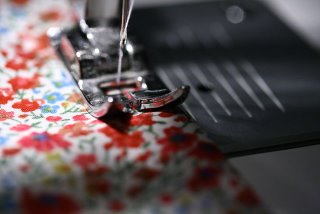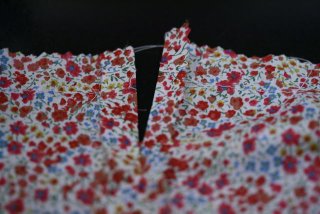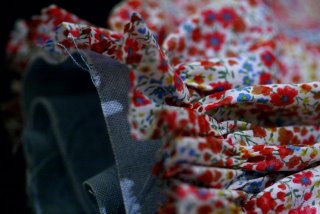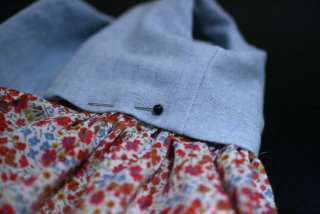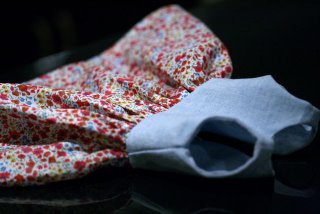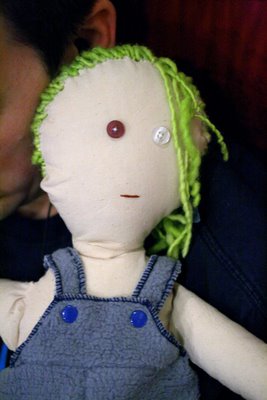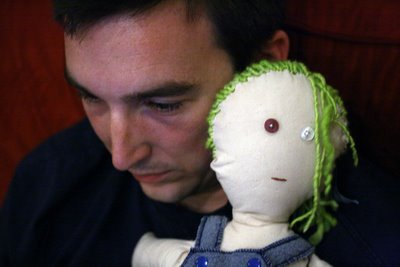I was wandering in a shop in XinTianDi one day and saw the cutest stuffed patchwork cube. Wow, I thought, what an ingenious idea. I thought Wow! again when I looked at the RMB400 price tag (about US$50). For some perspective, our ayi in Shanghai made RMB1,000 a month, so there was no way I was going to buy this little cube for such an outrageous sum. I traipsed off home to recreate the design, and it actually worked.
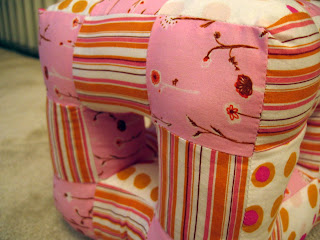
Here is a tutorial for the patchwork cube, in case any of you guys would like to try one as well. This project gets a little tricky at the end, but it will come together with a little faith and patience. Basic sewing skills are a must. If you are struggling with the sewing machine in general, then this project may be frustrating. Have heart, though!
Materials needed
Sewing machine
A little less than 1/4 yard each of three types of fabrics (hereafter referred to as fabric A,B,C) NOTE: This yardage estimate is for three inch squares.
Coordinating thread
Hand sewing needle
Iron and ironing board
Sharp scissors
Stuffing (e.g., washable poly-fill)
Step 1: PreparationBegin by cutting out 24 squares each of fabric A,B and C for a total of 72 squares. You can make your squares any size you like; the bigger the squares, the larger the cube. I used three inch squares and a 1/4 inch seam allowance for the cube displayed above. You can go smaller, but keep in mind you will be doing a lot of turning and seaming from within at the end, so really small squares may be hard. Start big and move to smaller squares as you get comfortable with the technique.
Divide your squares into two groups: one group with 16 squares of A,B,C (total of 48 squares) and a second group with 8 squares of A,B,C (total 24 of squares). Set the second group aside. Further subdivide the first group into six sets of eight squares, with two types of fabric in each set. You will use these blocks to create the foundation blocks, the six outer sides of the cube, so fabric layout becomes important. Here is a sample guide, which I used for my cube. This picture assumes you will make two of each type block for a total of six blocks.

Of course, you can do whatever you like. I did not want any two squares of the same fabric touching on the outside of the cube, and this is the simplest layout that will achieve that goal.
Step 2: Foundation BlocksStart piecing each of the sets (six of them) together. These are your foundation blocks. Foundation blocks have an empty center and three blocks on each side.

Sew your squares together into foundation blocks, right sides facing. I used 1/4 inch seam allowances, but do whatever makes you comfortable. All things equal, the larger the seam allowance, the smaller the end square.
TIP: Backtack at the beginning and end of each seam segment. This will become crucial as your seams begin to interlock. I also find it helpful to cut of the hanging threads as I go, else they get in the way really fast.
Here is a picture of the underside of a finished foundation block. Seams are pressed open (or to one side as you prefer).

Here are all six finished blocks. In this picture, the blocks are arranged in their finished cube order.
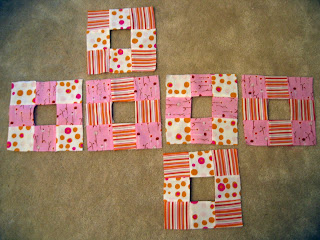 Step 3: Inner Boxes
Step 3: Inner BoxesNow turn to your second group of squares, the 24 that were reserved at the end of Step 1. Further subdivide them into six sets of four, with two types of fabric in each set (e.g., two each of A,B,A,B and B,C,B,C and C,A,C,A). Sew each set of four squares into a box, open on the top and bottom, like this.

These are your inner boxes, which you will next attach one to each of the foundation blocks created in Step 2 above.
Step 4: Attaching the Inner BoxesThe goal of this step is to get all six of the inner boxes attached to the inside area of the foundation blocks. You will wind up with the inner box sticking up out of the center of the foundation block, creating a perpendicular structure.
Start by placing one right side of an inner block to the inside of one inner part of a foundation block. Sew that seam, backtacking at both ends. Turn the work and reposition the adjacent box edge to the next inner foundation block edge. At this stage it becomes important to be aware of your seam allowances as you begin and end each of the inner seams. Leave some space at the start and finish approximately equal to your seam allowance. This will become more intuitive as you start working on it, though.
Here is a shot of the underside of the finished perpendicular structure.

And here are all six blocks, ready for Step 5.
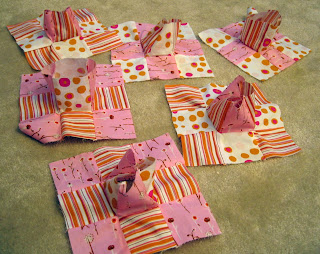 Step 5: Assembling the Sides
Step 5: Assembling the SidesNow for the fun part - assembling the cube. Lay out your six blocks in the correct order. Then take the top and bottom pieces and put them aside.
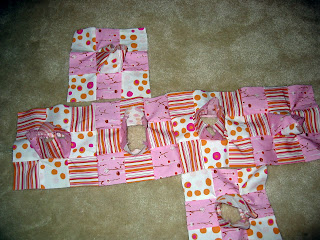
Assemble the four middle pieces into a box by seaming four long lines, one on each edge, right sides facing. After this step, the box looks like this.

Now retrieve the top and bottom pieces and sew them onto the two open ends of the cube. Leave a wide opening on one side of either the top or bottom (which is which anyway?) so that you can turn the cube inside out, finish the inside seaming and then stuff.
This opening should be pretty wide because you will be pulling fabric through to seam it in Step 6 below. I like to leave most of one whole side open for this purpose, sewing only around the corners and a little way in on each side for neatness. Here is what your cube looks like once the top and bottom have been added (still inside out).

Turn your cube right side out. Each side will have the inner box sticking straight out. It looks like this.

Now push each of the six inner boxes inside the cube. Like this.
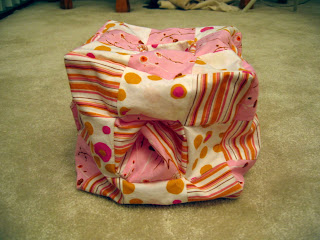
At this stage, it would be really helpful for you to pick up the structure and feel around inside to get a sense for how the remaining seams need to come together to make the cube. Got the picture in your head? Alright, now let's proceed to Step 6.
Step 6: Inside SeamingFirst, put your work down and go pour yourself a glass of wine. It works for me anyway.
Relax and have faith that this step is easier than it appears at first glance. Reach inside the cube and grasp two squares that should be seamed together. How do you know if the squares should be seamed together? Well, this is where having a good visual image of the finished structure is really helpful. If you reach in from the top and from the left, for example, the top square of the inner box on the left (which faces into the cube from the left) will join with the left square of the top box (which faces down into the cube). Put your hands into the cube and you will see that these two squares line up naturally.
Take a look at the fabric patterns of the two squares in your hand to make sure you end up seaming the correct two squares. Grab onto the two squares tightly and pull them out though the turning opening. You may have to drag them through some tunnels of fabric to get them into the open for sewing. The cube will be half inside out, half right side out. Then sew the squares together, right sides facing and backtacking at both ends.
Restore the newly seamed squares back to their rightful place inside the cube and check to make sure you did it correctly. If all is well, then proceed to the next two squares. If you somehow seamed the wrong two squares together and the structure is now all wonky - no worries! Just get out your seam ripper and start again.
Seam all inner squares in this way until the cube is whole with no inside gaps. You are now ready to stuff!
Step 7: StuffingFor most of my dolls, I prefer using wool stuffing because it adds a really nice weight and feel. However, the cube is probably going to be used most by someone who drools a lot, so it is probably better off full of machine washable polyfill.
I like to stuff my cubes firmly as it gives a nice sturdiness and definition to the structure. Once the object is stuffed, use a whipstitch or similar stitch to close the turning opening.

That's all there is to it. Please be sure to
let me know if you make a cube using this tutorial. I would be tickled to see it. Also give me a shout if you run into problems, and I'll try to troubleshoot. Have fun!

Labels: sewing, tutorial

